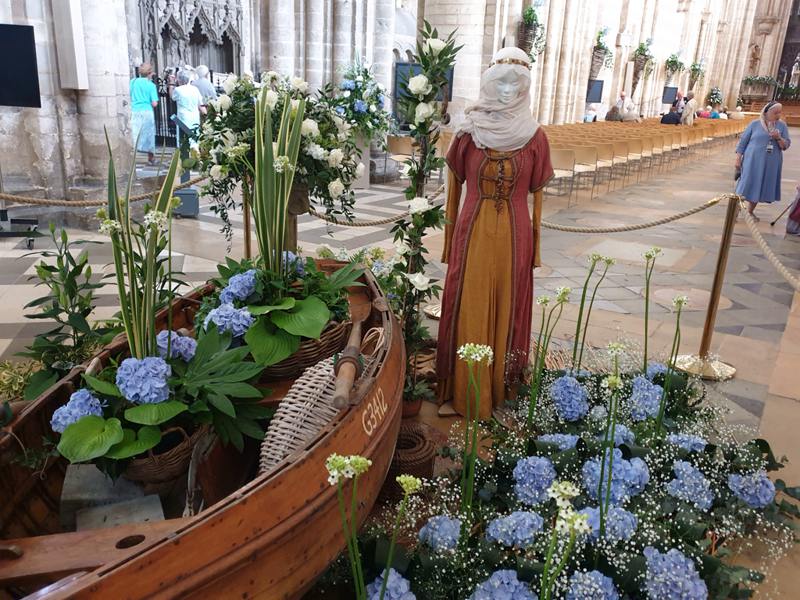The year was 673 AD when the Anglo-Saxon Queen Aethelthryth set foot again on her Ely lands For her this was a longed-for homecoming and the beginning of her heart’s desire. You might be more familiar with her by one of the other names bestowed on her over the centuries: Saint Etheldreda (which means “noble strength”) or Ediltrudis or Audrey.
That Newmarket has two churches which include her in their dedications also indicates that Etheldreda was a local girl, born in Exning to King Anna of East Anglia and his Queen Saewara in 636 AD. The family were of the Royal ‘Wuffing’ dynasty. These churches are the ‘Church of Our Lady Immaculate and St. Etheldreda’ and the Hospital Chapel of ‘St. Philip with St. Etheldreda’
The palaces of Anglo-Saxon kings were large, wooden, aisled halls. Archaeology has demonstrated that such a building seems to have stood in Exning on, or near, the site of St. Martin’s church. Histories have long maintained that the church is built on the site of Etheldreda’s birthplace, adjacent to the spring of water where her family were baptised as Christians. The spring still exists.
At that time there were seven Anglo-Saxon kingdoms in England, Some, like the large Pagan Kingdom of Mercia, were aggressive. This caused problems for Christian East Anglia. In response, a series of huge, protective earthworks or “dykes” were built to fill gaps between fen and forest. The Devil’s Dyke, near Newmarket, was the longest of these (7 miles).
Note that the Fens were then much larger than today; a vast, watery wilderness stretching down from The Wash, presenting a formidable natural barrier to potential inland invaders, whose only approach was from the south. Outsiders were generally afraid to venture in but numerous Fen islands were inhabited by locals who made a good living from fish, fowl and other resources. Their island place names end in ‘ea’ or ‘y’.
A princess was expected to make a marriage which was advantageous for her people. Etheldreda’s family matched her with an older Fenland Ealdorman, a widower called ‘Tonbert’. Etheldreda’s wishes were to serve God as a nun. However, the marriage brought Etheldreda a gift of land, including the Isle of Ely.
After Tonbert’s death, Etheldreda hoped for a religious life but, again, her Royal status could help East Anglia. This time she became Queen of Northumbria and was wed to King Ecgrig. She was possibly around 24 at the time and he was around 14.
In both marriages Etheldreda made it plain that she only wanted to live a nun’s life and it is said that she remained a virgin. Few people today would understand this thinking but throughout the medieval Christian world it was understood as a matter of wanting to be pure and to devote one’s self and life to Jesus.
However, Ecgrig’s mistress was ambitious to be queen. After letting Etheldreda go Ecgrig then changed his mind. She fled with 2 nuns but Ecgrig pursued her It is said that God held Ecgrig’s forces back and the 3 ladies managed to escape through wild country and finally, through many dangers, into the Fens, In pictures Etheldreda carries a sprouting staff because she plunged it into the ground and God caused it to sprout and grow. Finally, Etheldreda and her companions safely stepped ashore onto her own Isle of Ely.
This year, Ely Cathedral is celebrating Etheldreda’s foundation of a double Benedictine monastery in 673 AD and 1450 years there of prayer, praise and worship to God through Jesus.
For Cathedral events see: https://www.elycathedral.org/about/history-heritage/st-etheldreda
For more local history visit: Newmarkethistory.org
History
The Queen Returns-by Sandra Easom, Chair, Newmarket Local History Society

